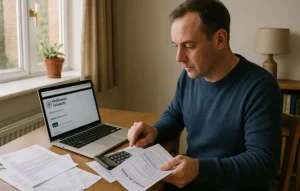How to Claim Working from Home Tax Relief? | Step by Step

Working from home has become a norm for many employees across the UK, offering flexibility and better work-life balance. However, it also brings extra household expenses that often go unnoticed, until the energy bills arrive or mobile usage increases.
For those required to work remotely, HMRC offers a tax relief scheme that can help cover part of these costs.
This guide explains how you can claim tax relief for working from home in 2025. Whether you’re unsure if you’re eligible, want to know what expenses are covered, or need help with the claim process, this step-by-step blog walks you through everything in a clear and simple way.
What is Working from Home Tax Relief?
Working from home tax relief is a government provision that allows employees to claim relief on additional household costs incurred due to remote work. This isn’t a cash payout; instead, it’s an adjustment in your tax code that reduces the amount of income tax you pay.
This relief is meant for employees who are required to work from home by their employer. It covers only the additional costs directly related to work, not general home expenses.
When you work from home, you’re likely to use more electricity, gas, and even water. If you’re making business-related phone calls, that adds up too. HMRC recognises this and allows tax relief to support employees facing such costs.
However, not every cost qualifies. The relief is strictly limited to expenses that are necessary and exclusively work-related.
If something is used both personally and professionally, such as your broadband or rent, you can’t claim relief on that unless there is clear evidence of exclusive business use.
Who Is Eligible for Working from Home Tax Relief in the UK?

Understanding eligibility is key. Not everyone who works from home qualifies. HMRC has strict rules to ensure the relief is given only to those who are required to work from home.
You May Qualify If
- Your job requires you to work from home, either full-time or part-time.
- Your employer does not have an office, or you are based far from your company’s location and cannot reasonably commute.
- You work remotely because your employer has no workspace available on specific days.
- You are under a formal working agreement where home working is mandatory.
This does not mean flexible work by choice. The need must come from the nature of your job or employer’s requirement.
You Are Not Eligible If
- You choose to work from home (e.g. for convenience).
- Your employer offers you office space, but you opt not to use it.
- Your employment contract includes hybrid work or optional remote work
- Your employer has already reimbursed you for these expenses.
It’s important to check with your employer before claiming. HMRC may request proof that remote work was necessary.
Who Cannot Claim Tax Relief When Working from Home?
Not every remote worker qualifies, and the rules have become more specific since the end of the COVID-19 pandemic.
Ineligible Scenarios
HMRC states you cannot claim if:
- Your employment contract allows you to work remotely at your discretion.
- Your employer offers hot-desking or flexible office spaces, even if they are occasionally full.
- You previously claimed during the pandemic but no longer meet current requirements.
- You have already been reimbursed by your employer for household expenses.
- You are self-employed. In this case, different expense rules apply through Self Assessment.
Why This Matters in 2025?
Post-pandemic, HMRC has re-tightened the eligibility criteria. Claims are now carefully reviewed, and invalid claims are often rejected. Anyone who falsely claims may have to repay the tax adjustment and could face penalties.
What Expenses Can You Claim Tax Relief For When Working Remotely?

The relief covers a narrow range of expenses that arise directly because you’re working from home. These must be extra costs that wouldn’t have occurred otherwise.
Allowable costs include a proportion of your energy bills. If you’re heating or lighting your home office during work hours, the increase in your gas or electricity bill could be claimed. Similarly, work-related phone calls made from a personal line may be included, provided they are not reimbursed.
Water bills may also be eligible if you’re on a metered supply and your usage has increased due to home working.
However, many commonly assumed expenses are not covered. For example, rent or mortgage payments are not claimable. Broadband, even though necessary for work, cannot be claimed unless it’s used only for business purposes, which is rare for most households.
You also can’t claim for items like coffee, food, or furnishings, unless they are wholly and exclusively used for business and not reimbursed by your employer.
How to Claim Working from Home Tax Relief? | Step by Step
The process varies depending on how you pay tax.
For PAYE Employees
If you’re on PAYE and don’t do a Self Assessment return, you can claim using HMRC’s online portal.
Step-by-step:
- Sign in to your Government Gateway account.
- Confirm your eligibility by answering a short questionnaire.
- Choose your preferred claim method (flat rate or actual).
- Provide employer details and the dates you worked from home.
- Submit your claim.
If approved, HMRC will update your tax code. The change usually reflects in your payslip within a few weeks.
For Self Assessment Users
If you already complete a Self Assessment tax return:
- Navigate to the ‘Employment’ section of your online return.
- Enter your home working expenses under ‘Employment Expenses’.
- Upload supporting documents if claiming actual costs.
- Submit the return by the 31 January deadline.
Tax relief is calculated automatically and reflected in your tax bill or refund.
How Much Tax Relief Can You Actually Claim?

There are two ways to calculate how much you can claim:
- Flat rate method
- Actual cost method
Most employees prefer the flat rate method because it doesn’t require receipts or calculations. You simply claim £6 per week for the weeks you worked from home. If you worked from home for the full year, that’s £312 in total.
Here’s how this works based on tax rates:
| Tax Band | Yearly Claim (£6/week) | Tax Relief Amount |
|---|---|---|
| Basic Rate (20%) | £312 | £62.40 |
| Higher Rate (40%) | £312 | £124.80 |
If you choose to claim based on actual costs, you must calculate the work-related portion of your household bills. This requires detailed records, and you can only claim the part directly related to your professional use.
For example, if your yearly electricity bill is £1,000 and you estimate that 30% of it is due to work, your work-related expense is £300. If you’re on the basic tax rate, you would get £60 in tax relief.
How to Calculate Working from Home Tax Relief?
Let’s look at an example calculation using both methods.
Flat Rate Method
This method allows you to claim a fixed £6 per week without needing receipts or calculations. It’s simple and ideal for employees who prefer a hassle-free claim process.
Sarah is a full-time remote employee on a £30,000 salary, paying the basic rate of tax.
- She claims £6 per week.
- That totals £312 annually.
- 20% of £312 = £62.40 in tax relief
This amount is deducted from her taxable income, increasing her take-home pay across the year.
Actual Cost Method
This method involves calculating the specific portion of your household expenses used for work. It requires detailed records but can result in a higher tax relief if your costs are significant.
Tom works remotely 3 days a week and tracks his energy usage.
- Total annual energy bill: £1,200
- Work-related usage (estimated): 30%
- Work-related cost: £360
- Relief: 20% of £360 = £72
Tom must retain all supporting documents in case of an HMRC audit.
What Supporting Documents Do You Need for a Successful Claim?

The type of documents you need depends on the method you choose.
If you’re claiming the flat rate, you generally don’t need to provide any receipts. HMRC may request evidence of your working situation, such as a letter from your employer confirming that you were required to work from home.
If you’re claiming actual expenses, documentation is essential. You’ll need:
- Copies of utility bills that show increased usage
- Receipts for phone charges or other claimable costs
- A breakdown of how you calculated the work-related portion
- A written statement or formal agreement from your employer outlining your work-from-home requirement
Keeping organised records not only helps with your current claim but also protects you in case of future audits.
Can You Backdate a Work From Home Tax Relief Claim?
Yes, you can backdate your claim for up to four previous tax years, provided you were eligible during those periods.
For example, if you started working remotely in 2021 and continued through to 2025, you can claim tax relief for each year individually. Each claim must match the actual number of weeks worked from home in that tax year.
Let’s say you’re a basic rate taxpayer and claim the flat rate for all four years:
- 2021–2022: £62.40
- 2022–2023: £62.40
- 2023–2024: £62.40
- 2024–2025: £62.40
Your total tax relief could be £249.60.
To backdate your claim, you can either use HMRC’s online tool or submit a P87 form by post. Make sure to check the deadlines and include accurate dates for each period.
Real-Time Example: Jane’s Experience Claiming Work From Home Tax Relief
Jane is a finance officer who began working remotely in 2022 after her employer closed their physical office. Since she was now required to work from home full-time, she became eligible for HMRC’s tax relief scheme.
Rather than tracking every bill, Jane opted for the flat rate method. She claimed £6 per week and received £62.40 in relief per year at the basic tax rate. Over three years, she also backdated her claim and received nearly £190 in total.
What worked well for Jane was how simple the process was. She only needed her National Insurance number, employer details, and access to her Government Gateway account. She recommends others in similar situations take advantage of the scheme.
What Are the Most Common Mistakes That Invalidate Claims?

Many claims are rejected due to misunderstanding HMRC’s criteria. Here’s what to avoid.
Top Mistakes
- Choosing to work from home and claiming without being required to
- Claiming already reimbursed expenses
- Incorrect calculations of actual costs
- Claiming for non-allowable items like rent or internet
- Not providing supporting documents for actual cost claims
Double-checking your eligibility and records before submitting will help you avoid delays or rejections.
Conclusion
Working from home has financial implications, but HMRC’s tax relief scheme can ease some of that burden. Whether you choose the simple flat rate or opt to calculate your actual expenses, the key is to ensure you meet the eligibility criteria and keep your information accurate.
For UK employees required to work remotely, this relief could mean more money in your pocket, especially if you haven’t claimed for previous years. Don’t miss the chance to reduce your tax bill for expenses you’ve already incurred.
If you haven’t made a claim yet, now is the time to act.
Frequently Asked Questions
What if my employer has already reimbursed me?
You cannot claim tax relief for any expenses your employer has already reimbursed.
Do I need to keep receipts if I claim the flat rate?
No, but you must confirm that working from home was required by your employer.
Can I claim if I work from home part-time?
Yes, if you are required to work from home for part of the week, you can still claim for those weeks.
How long does the claim process take?
If submitted online, claims typically reflect in your tax code within 2 to 4 weeks.
Can I claim for broadband or rent?
Not unless they are used exclusively for work, which is rare. Mixed-use items are not eligible.
What happens if I submit an incorrect claim?
HMRC may ask you to repay the relief and, in some cases, impose penalties.
Is this relief available to the self-employed?
No, self-employed individuals must use separate Self Assessment rules for business expenses.



